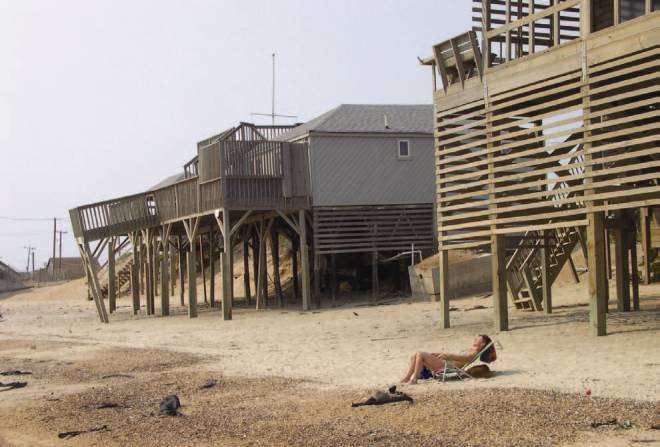- Causes of Future Sea Level Rise
- Elevation Maps
- Will we really lose all that land?
- Sea Level Rise Planning Maps
Adapting to Sea Level Rise
We can respond to rising sea level by moving inland or by holding back the sea. People have been doing both for thousands of years, so the basic engineering approaches for holding back the sea is well-established, and the law is generally clear on how shifting shores change land ownership. But we are not always very good at deciding which path to follow. In some cases the public interest in environmental preservation or having an open public beach collides with private property interests more concerned with a particular building in a particular location. Sometimes what makes sense in tbe short run (like building a dike to protect a community) leaves us with something that is not very sustainable in the long run (like having communities well below a rising sea level). Holding back the sea requires technology to manage the forces of nature, a retreat requires the management of human expectations.
Here are some reports that examine adaptation to sea level rise.
 Sunbathing in front of septic tank and condemned homes on eroding shore in Kitty Hawk, North Carolina.
Copyright Risingsea.net.
Sunbathing in front of septic tank and condemned homes on eroding shore in Kitty Hawk, North Carolina.
Copyright Risingsea.net.
|
Reports and other products
- US Climate Change Program's official primer on the three pathways for responding to sea level rise: shoreline armoring, elevating land surfaces, and retreat.
- EPA's argument for why it is urgent to decide which pathway particular communities will follow (PDF 17pp 15.2MB) , and why the failure to pick the pathway is the most fundamental barrier to preparing for sea level rise.
- Even though a large rise in sea level is uncertain and far into the future, for some decisions it is rational to prepare now and unreasonable to not prepare for sea level rise (20 pp, 4.6MB), according to this official statement by the US Climate Change Program.
- America's failure to prepare for sea level rise seems to have resulted from instutional barriers and biases such as the bias of shore protection over retreat, structural protection over nonstructural living shorelines, coastal development over leaving land vacant, as well as a general institutional inertia that slows any effort to address a new problem, according to this official report by the US Climate Change Program.
- Property rights are important. Governments seem to be interfering with property rights when they tell someone that they must allow eroding shores and rising seas to take that land. But that is exactly what we will have to do if we want public beaches and wetlands to survive rising sea level--and to not end up with hundreds of cities below sea level. Fortunately, policies can ensure a gradual retreat from low-lying ares without a largescale unconstitutional taking of private property--but only if we enact it now, long before most of the land becomes inundated. An article in Maryland Law Review proposes the idea of rolling easements as a general solution to sea level rise that state and local governments and private conservancies can implement. An article in Golden Gate Law Review looks at the possible federal role.
- The idea of a rolling eaesment sounds great, but almost no one is implementing it. Meanwhile, the Corps of Engineers issues permits to build bulkheads that block the inland migration of wetlands and beaches without even looking for alternatives or requiring mitigation of the environmental damage. That's illegal. The Clean Water Act only allows these nationwide permits if they have no cumulative environmental impact. The Corps assumes that bulkheads have no cumulative impact based on the assumption that sea level is stable--the Corps assumes that wetlands have no need to migrate inland. But please: Do not sue the Corps now. They need time to develop a policy that is both effective and legal.
- How often will this really be a problem? How much land is vacant where shores will just retreat with no conflict? How much land is sure to be protected from the rising sea. Realistically, where do we still have a choice about whether to follow a retreat or shore protection pathway? EPA's unpublished $2 million sea level rise planning study examined this question for the US Atlantic Coast and part of the Gulf Coast--and some of the results are in an article in the journal Environmental Research Letters.
